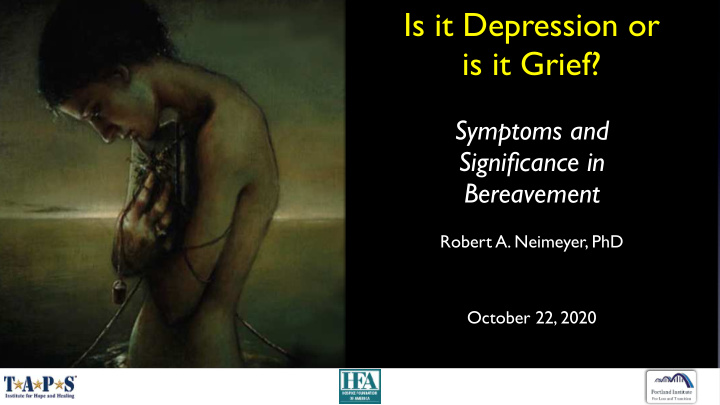



Is it Depression or is it Grief? Symptoms and Significance in Bereavement Robert A. Neimeyer, PhD October 22, 2020
The Well of Grief David Whyte
Today’s Goals • Compare and contrast symptoms of depression and grief in bereavement • Recognize the role of a quest for meaning in mourning, and growth in grief • Identify some practical principles for addressing both forms of distress in bereavement
Depression vs. Grief • Maintained connections to others • Self-focused, alienated from • Hope for improvement others • Hopelessness • Overall feeling of self-worth • Low self-esteem, self-loathing • Guilt and regret about “letting • Guilt about feeling worthless or down” the deceased • Loss of pleasure related to useless to others • Pervasive inability to experience longing for loved one • Suicidal feelings related to pleasure with people or activities • Chronic feelings of not wanting to yearning for reunion live; acute suicide risk • Consoled by friends, music, etc.
The Toll of Tragic Loss: Grief, Trauma and Depression in Bereavement McDevitt-Murphy, Neimeyer et al., Psychological Trauma
Incidence of Co-occurrence of PTSD, CG, and Depression PTSD, CG, and Depression (N=43) PTSD PTSD 19% 19% Complicated CG Grief 56% 56% Depression Depression 49% 49% 37% None 37% None
Co-morbidity of PTSD, CG, and Depression CG Total PTSD total 56% 19% CG only 19% 14% Dep. only Depression CG & 23% 7% Depression Total 49% None 37%
Adaptive Grieving Integrated Grief Acute Grief Processes -Finality of death acknowledged • Process “event story” of the -Bittersweet emotions accessible & changing death, attempting to make sense -Mental representation of it and its meaning for our lives now of deceased revised -Coherent narrative of • Access “back story” of loss formulated relationship to restore attachment -Life goals security and resolve unfinished redefined business with the deceased
Sense-making predicts better grief adaptation in: • Palliative care • Natural death losses • Violent death losses • Bereaved: • Parents • Spouses • Young adults
Complicated Grief Symptoms & Posttraumatic Growth Currier, Holland & Neimeyer, Traumatology • 617 ethnically diverse adults in first two years of loss • Controlled for cause of death, nature of relationship and other background factors F o r P e e r R e v i e w
Principles of Practice • Stabilize depression when present • Draw on people’s prior resources for coping • Practice self-soothing skills • Seek supportive interactions with others: DLRs • Structure days with manageable goals • Name and claim grid-related emotions, and address the needs implicit in them • Honor the deceased, and restore the bond • Treat the trauma, when present • Find a way to tell the story, and make it whole • Integrate the loss into life in a way that promotes growth and the capacity to love • Medicate depression when necessary, not grief Boy van Dulman: Omdat ik hou van jou
Travelers Lisa Jennings: The Eternal Circle
Questions?
Recommend
More recommend